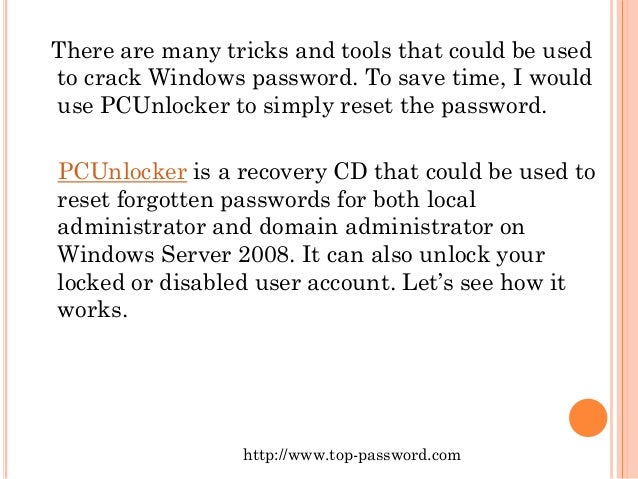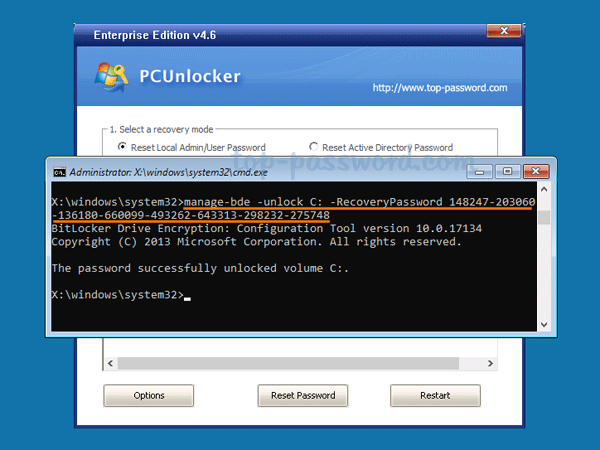How To Use Pcunlocker
With that said, you can now move on to the second process which will take care actually unlocking your PC using the PCUnlocker. How to Use PCUnlocker? The whole process consists of 3 stages. In the first stage, you have to choose whether you want to reset local admin or user password, or you can choose to reset active directory password. Windows OS is wide used OS known as Windows Operating System which serves as the intermediary between users, hardware and all other components of the computer. It is world popular used OS on both desktop and other devices that uses OS. 3Insert the USB Driver to Your Locked Computer and Set Your PC Boot from USB. Now, switch to your locked computer, insert the burned USB disk to your locked computer. Restart your computer and then press the right key to access BIOS and set BIOS to boot from USB. This process is different from computer brands.
Forgot the administrator password on your laptop or desktop computer? Locked yourself out of Windows after too many incorrect password attempts? Microsoft’s official method to reset a forgotten Windows password is using a password reset disk. If you wait until you’ve forgotten your password, it’s too late and you have to find ways to unlock your computer without a password reset disk.
If your Windows account is locked with a simple or short password, there is still a chance that you can recover the lost password using third-party password cracking tools. In most cases, it would fail because brute force attacks aren’t very effective.
Nevertheless, you can still reset or bypass Windows user password with a bootable media – PCUnlocker. Due to its simplicity and functionality, it has become the most popular Windows password recovery tool available to computer technicians and beginners. Let’s find out how you can make the most out of the PCUnlocker utility.
Run PCUnlocker from CD or USB
When you forgot the password of the sole administrator account on your PC, there are no ways to get past the login screen, not to mention installing a software for circumventing security restrictions on Windows. In order to reset or bypass Windows password, you have to boot your computer into a second operating system from a CD/ USB drive, so you can access the Windows installation while it is offline.
PCUnlocker is a self-contained boot image that you can run from either a CD or a USB flash drive. After you’ve downloaded the PCUnlocker ZIP archive (trial version), right-click on it and select “Extract All” from the context menu.
After extraction is complete, a new folder window will open containing the files inside the ZIP. From there, you can see the pcunlocker.iso file, which is a disc image that you can burn it onto a CD/USB using your preferred disk burning software (for example ISO2Disc, Rufus).
Once you’ve made a PCUnlocker boot CD (or USB drive), insert it into the Windows PC you’re locked out. Next, change the boot priority in the BIOS and set the machine to boot from CD (or USB).
Reset / Remove Windows Password
It’s known that Windows stores user credentials in the Windows SAM database. After PCUnlocker loads from CD/USB, it automatically finds the SAM file stored on your hard drive and extracts the user account information from it. In the User Account list box, we can easily find which account is locked, disabled, expired or password protected.
Choose one of your user accounts and click the Reset Password button. It will instantly reset your forgotten login password, as well as restoring your account status back to normal.
Bypass Windows Password without Resetting
PCUnlocker can also bypass the authentication process of the Windows logon procedure, so you can log in to your Windows account, without knowing the password or resetting it. It works by modifying the kernel memory so that the login authentication is not required. This is a very useful feature for users to conduct security audits, penetration testing, forensics investigation, etc.
If you need to bypass Windows password without resetting, just click the Options button at the bottom left corner of PCUnlocker, and choose the “Bypass Windows Password” option from the menu. Click OK to proceed. Afterwards, reboot your PC and click any local account appeared on the login screen and you can get in with any non-blank password.
Reset Domain Administrator Password
After booting to the PCUnlocker program, click the “Reset Active Directory Password” recovery mode. It will automatically locate the core database (ntds.dit) of Active Directory and list out all the domain accounts on your domain controller.
Choose the domain administrator account and click on Reset Password button. The program will quickly reset your domain login password to “Password123” (without quotes). If your domain user was originally locked or disabled, you’ll find the account status comes back to normal after you reset the password. Reboot your server and you can then log in.
Conclusion

When you’ve forgotten Windows password, you can also choose to perform a system restore if you have a backup point created before you set your password. But, your new data added after the backup point will be lost. Using PCUnlocker you can easily reset / bypass Windows 10/8/7 password without data loss, especially helpful when you haven’t created a password reset disk or make a system backup ahead of time.
This is a sponsored article.

Enable BitLocker encryption, and Windows will automatically unlock your drive each time you start your computer using the TPM built into most modern computers. But you can set up any USB flash drive as a “startup key” that must be present at boot before your computer can decrypt its drive and start Windows.
This effectively adds two-factor authentication to BitLocker encryption. Whenever you start your computer, you’ll need to provide the USB key before it will be decrypted. This would be particularly useful with a small USB drive you carry with you on a keychain.
Step One: Enable BitLocker (If You Haven’t Already)
This, obviously, requires BitLocker drive encryption, which means it only works on Professional and Enterprise editions of Windows. Before you can follow any of the steps below, you’ll need to enable BitLocker encryption on your system drive from the Control Panel.

If you go out of your way to enable BitLocker on a PC without a TPM, you can choose to create a USB startup key as part of the setup process. This will be used instead of the TPM. The below steps are only necessary when enabling BitLocker on computers with TPMs, which most modern computers have.
If you have a Home version of Windows, you won’t be able to use BitLocker. You may have the Device Encryption feature instead, but this works differently from BitLocker and doesn’t allow you to provide a startup key.
Step Two: Enable the Startup Key in Group Policy Editor
Once you’ve enabled BitLocker, you’ll need to enable the startup key requirement in Windows’ group policy. To open the Group Policy Editor, press Windows+R on your keyboard, type “gpedit.msc” into the Run dialog, and press Enter.
Head to Computer Configuration > Administrative Templates > Windows Components > BitLocker Drive Encryption > Operating System Drives in the Group Policy window.
Double-click the “Require Additional Authentication at startup” option in the right pane.
Select “Enabled” at the top of the window here. Then, click the box under “Configure TPM Startup Key” and select the “Require Startup Key With TPM” option. Click “OK” to save your changes.
Step Three: Configure a Startup Key for Your Drive
You can now use the manage-bde command to configure a USB drive for your BitLocker-encrypted drive.
How To Use Pcunlocker With A Flashdrive
First, insert a USB drive into your computer. Note the drive letter of the USB drive–D: in the screenshot below. Universal keygen download for pc. Windows will save a small .bek file to the drive, and that’s how it will become your startup key.
Next, launch a Command Prompt window as Administrator. On Windows 10 or 8, right-click the Start button and select “Command Prompt (Admin)”. On Windows 7, find the “Command Prompt” shortcut in the Start menu, right-click it, and select “Run as Administrator”
Run the following command. The below command works on your C: drive, so if you want to require a startup key for another drive, enter its drive letter instead of c: . You’ll also need to enter the drive letter of the connected USB drive you want to use as a startup key instead of x: .
The key will be saved to the USB drive as a hidden file with the .bek file extension. You can see it if you show hidden files.
How To Use Pcunlocker Program
You’ll be asked to insert the USB drive the next time you boot your computer. Be careful with the key–someone that copies the key from your USB drive can use that copy to unlock your BitLocker-encrypted drive.
To double-check whether the TPMAndStartupKey protector was added properly, you can run the following command:
(The “Numerical Password” key protector displayed here is your recovery key.)
How to Remove the Startup Key Requirement
Pcunlocker Live Cd Free
If you change your mind and want to stop requiring the startup key later, you can undo this change. First, head back to the Group Policy editor and change the option back to “Allow Startup Key With TPM”. You can’t leave the option set to “Require Startup Key With TPM” or Windows won’t allow you to remove the startup key requirement from the drive.
Next, open a Command Prompt window as Administrator and run the following command (again, replacing c: if you’re using a different drive):
This will replace the “TPMandStartupKey” requirement with a “TPM” requirement, deleting the PIN. Your BitLocker drive will automatically unlock via your computer’s TPM when you boot.
To check that this completed successfully, run the status command again:
Try rebooting your computer first. If everything works properly and your computer doesn’t require the USB drive to boot, you’re free to format the drive or just delete the BEK file. You can also just leave it on your drive–that file won’t actually do anything anymore.
If you lose the startup key or delete the .bek file from the drive, you’ll need to provide the BitLocker recovery code for your system drive. You should have saved somewhere safe when you enabled BitLocker for your system drive.
Image Credit: Tony Austin/Flickr